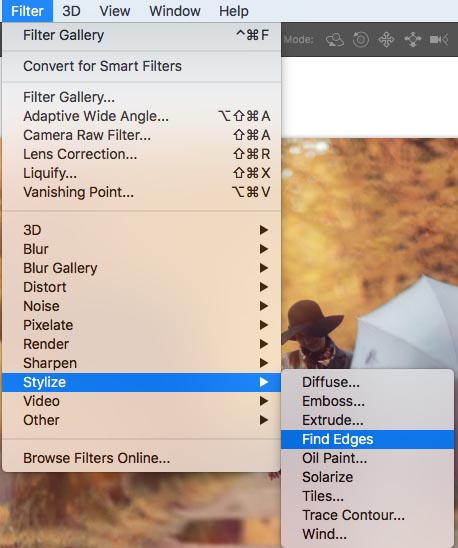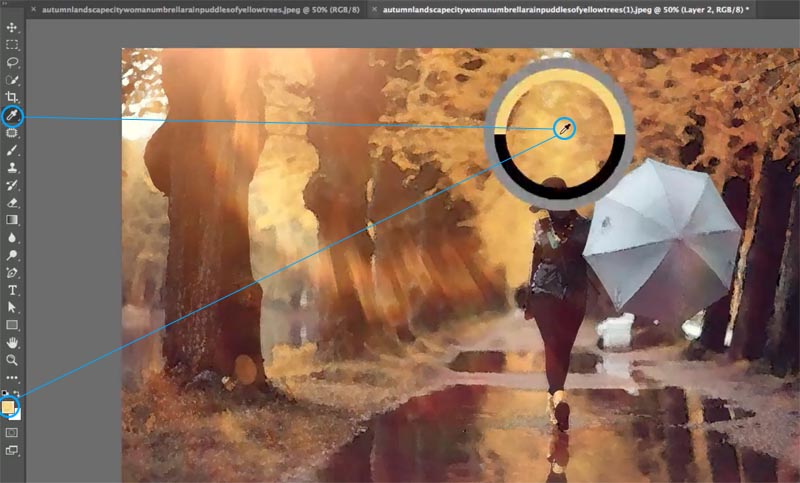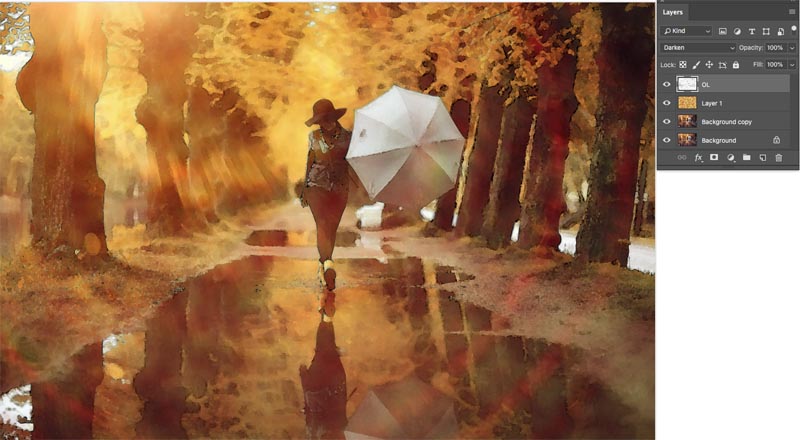
HOW TO USE PHOTOSHOP TO TRANSFORM ANY PHOTO INTO A WATERCOLOR PAINTING

STEP 1
Duplicate the Background layer (Ctrl/Cmd+J)

STEP 2: APPLYING THE BASIC WATERCOLOR FILTER
Let’s apply the basic effect. Filter>FilterGallery

Choose the top category, Artistic.
Click on Watercolor
- Brush Detail = 3
- Shadow Intensity = 0
- Texture =1
Click OK

You now have the basic water color effect (as seen in preview above). There is so much more we can do to add to realism from the basic filter and this is what will set your work apart from the rest, let’s go!
STEP 3: ADDING AN OUTLINE
Duplicate the background again and drag it to the top of the layers stack. Name it OL (outline).

Choose Filter>Stylize>Find Edges (an oldie, but a goodie).

You will now see a colored outline.

STEP 4.
Lets make it black and white. Press Cmd/Ctrl+Shift+U (desaturate)

STEP 5
Let’s use layer blending modes to hide all the white and just show the black, In the layer’s panel, change the mode from Normal to Multiply.

and here is the result.

Let’s hide the outline for now, click the eye to the left of the layer to hide that layer.

STEP 6: ADDING A WATERY COLOR EFFECT
This step is going to add to the overall painterly effect. Create a new layer by clicking on the new Layer icon at the bottom of the layers panel.
Move the layer between the background copy and OL layers as shown.

Choose the eyedropper tool
Click on the nice bright yellow color from the image. This will set the foreground color

We now want to set the background to another color in the photo that will complement the yellow. Lets choose the Orange brown, but wait!
We want to set the background color, so hold down the alt/option key when you click and the background color will be set.

Choose Filter>Render>Clouds

Let’s blend the new colors in.
Change the Layer blending mode to Soft Light

See the nice effect we are starting to get?

Sometimes you can still see the pattern of the clouds, so let’s soften that effect. Choose Filter>Blur>Gaussian Blur. I set it to about 8.

STEP 7.
Turn the Outline layer back on (OL). If it seems too dark, change the blending mode to Darken like I have done here (optional).

STEP 8. MAKING THE WATER COLOR LOOK DABBED ON WITH A BRUSH
This is the very best part of the tutorial and something else you won’t find anywhere else (Don’t you just love the original tutorials here at PhotoshopCAFE)? We are going to make it look like this was all painted carefully with brushes and sponges.
Unlock that background layer by clicking on the padlock. (Turns it into a regular layer).

Create a new layer at the bottom of the stack. (Choose the bottom layer and hold down Cmd/Ctrl while clicking the new layer icon, This creates a layer underneath the existing layer)

Fill it with white, or a faint color. This will be the new canvas color. (you will see soon).

STEP 9: CREATING A BRUSH
Let’s create a new document. Set it to1920X1080 with a white background.
File> New
Use the legacy dialog box

Or the newer one, doesn’t matter.

Click ok to create the new document.
Press the D key to reset the color swatches.

Choose Filter>Render>Clouds

Let’s make the shape of our brush.
Choose the elliptical Marquee tool.

Draw an oval. Tip: start in the center and hold down the Alt/Option key as you drag to draw from center.

Let’s soften the edge of the selection
Choose Select>Modify Selection>Feather
Set it to a nice big number like 100

Now it’s time to make it into a brush!
Choose Edit>Define Brush Preset
Name it Watercolor soft, or whatever you like really.

When you fill the page with white and tap once with black, this is what the brush should look like.
You can now close this new document, weldon’t need it any more, we have our brush.

STEP 10: USING THE BRUSH TO GET AMAZING RESULTS!
Alright, back to our water color image (Thank goodness we only have to create this brush once, and we will always have it for the future).
Select all the layers except for the background: Click on the top layer, hold shift and click on the Layer 0, all the layers between are now selected as shown.

Let’s put all the layers into a Layer group. Press the G key and you will see they are all nicely tucked away in a folder.

We want to add a Layer Mask, but a mask that will hide all the layers. Hold down Alt/Option as you click the new layer mask icon and you will see a black mask has been created. This hides everything.

Choose the B key to select the brush tool. Our cloud brush should still be selected. (If not, choose it from the Brushes panel).
At the top, drop the opacity to 30%. We want to gradually paint and build up the effect.

Choose white as the foreground color

Dab once on the canvas with the brush (layer mask selected). You can see that that it looks like we lightly painted on the page with real brushes and sponges.

Keep dabbing the effect, keep it lighter around the edges. You can use [ and ] to make the brush larger or smaller.

And here is the result. Pretty neat huh? Don’t forget to watch the video at the top for a walkthrough and a few extra tips.

Here is another example from a different photograph.

You May Also Like

AMAZING COLOR AND TEXTURE IN YOUR PHOTOS WITH LAB COLOR IN PHOTOSHOP TUTORIAL

USE PHOTOSHOP TO CREATE A REALISTIC BROKEN GLASS EFFECT.

